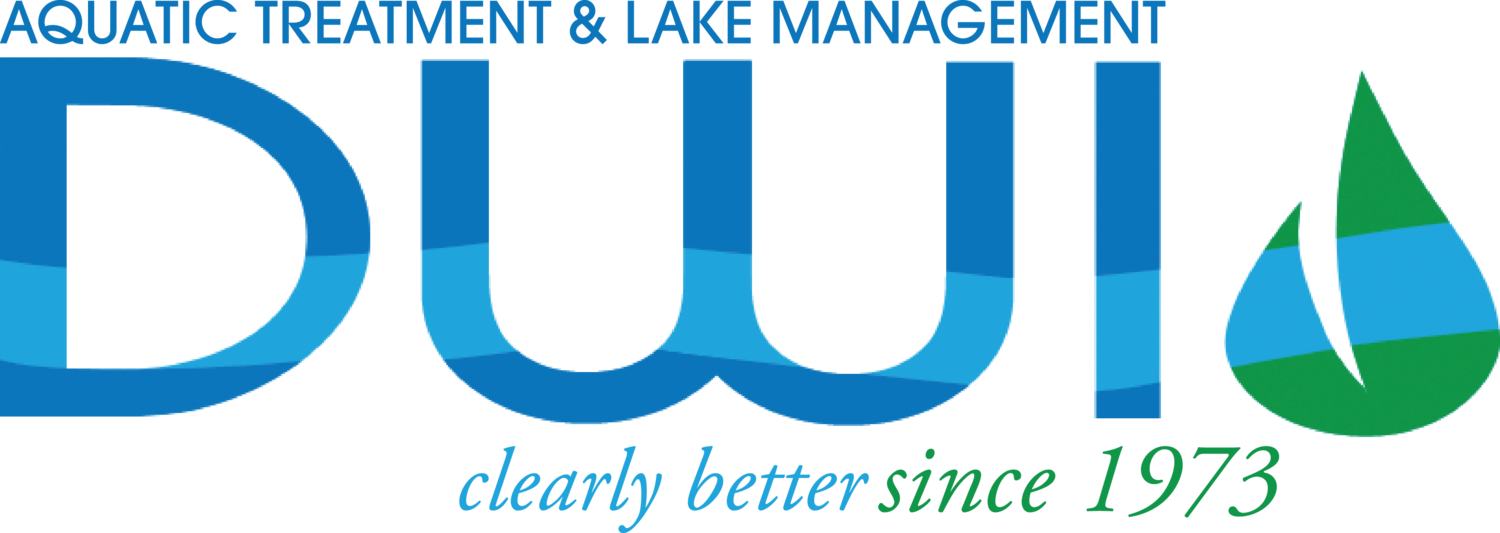The summertime beauty and function of a pond, lake, or water feature can be seriously threatened by problems that actually develop during the winter. Algae, aquatic weeds, fish kills, and odors are all caused by a buildup of debris and a lack of oxygen. These conditions develop during the fall and winter. The time to start preventing summer disasters is in the spring.
The water in our lakes is actually a solution of various chemicals and contains suspended organic materials. Various techniques enable water to achieve equilibrium — where natural decomposition is balanced with the amount of chemicals and organic materials entering the water. A program of clarification, proper water circulation, and sunlight suppression can correct winter contamination. These are far more desirable than severe measures, such as dredging and mechanical weed control.
Many things happen during the winter that disrupt the equilibrium of water bodies. Some of the most obvious are increased debris from trees and activity from migrating and native waterfowl. Some things take place that you can’t see. Rainfall increases during the winter. Rainfall contains a surprising amount of nitrogen picked up from the atmosphere. Runoff caused by rainfall also moves fertilizers and debris from the watershed into the lake. Rainfall can also change the chemical balance (pH) of water bodies.
More importantly, the process of biodegradation slows during the winter. The organisms in the water that break down leaves, bird waste, and dead fish function very slowly, if at all. They simply can’t keep up. When temperatures rise in the spring and summer, the contaminant load in the water is very high. These organisms require oxygen and a certain range of pH to do their job. Water holds only so much oxygen, depending upon the temperature and circulation in the water. The more oxygen consumed by microorganisms, the less is available for fish and other waterlife.
Fertilizers applied during the fall and winter also break down much more slowly. Landscape contractors apply nitrate forms of fertilizer (ammonium nitrate and calcium nitrate) to enable plants to obtain nitrogen and remain green during cooler times of the year. Consequently, the potential for fertilizer runoff is greater during the winter. Nitrates that reach water bodies encourage the establishment of aquatic weeds and blooms of algae later in the season.
Add it all up and you can see that the water in lakes, ponds, and water features needs help in late winter and spring. Lake health depends upon spring renovation.
Spring Lake Renovation
The goal of spring renovation is to bring the body of water back to equilibrium before high summer temperatures and sunlight favor aquatic weeds and algae. The goal is to reduce organic matter suspended in the water, adjust the pH of water to be favorable to chemical breakdown, and to improve the oxygen content. Other steps can be taken to improve lake health and discourage weeds, such as increasing lake depth, and circulation, using dyes to reduce sunlight penetration, and preventing runoff and debris from reaching the water in the lake.
Reducing organic matter involves filtration or treating the water to cause organic particles to settle to the bottom. Filters are mechanical devices that require pumps, piping, a filter media, and power. The equipment must be operated and maintained properly. The filter media must be flushed or replaced regularly to be effective. The time between filter maintenance events is determined by the load of suspended material in the water and the volume of water passing through the filter.
Treating a lake with chemicals requires sufficient circulation and an accurate calculation of the volume of water in the lake. The product needs to be both effective and safe for fish and irrigation, if the lake is used as a reservoir. It must be applied correctly and evenly distributed throughout the body of water. For these reasons, selecting a professional applicator familiar with treating lakes is extremely important.
Clarification treatment should be followed with other steps to reduce light penetration and increase oxygen circulation. And, of course, now is the time to get serious about preventing debris from trees and lawns from entering the body of water.
The acidity or alkalinity of a lake influences how rapidly organisms function to digest contaminants. These organisms perform best at a certain range of a measurement called pH, which represents the amount of hydrogen present in the water. A balanced pH is 7.0. Tree leaves and rain are acidic. Likewise, a lake with a limestone shoreline can become too alkaline. The lake pH can change over time and reduce the effectiveness of beneficial organisms. The lake can be treated to restore proper pH.
Lake Depth, Weeds, and Oxygen
Depending upon the size and depth of your water feature, some provision should be made to maintain circulation throughout the year. Circulation distributes oxygen through the entire volume of the water, improves decomposition of organic matter, and helps the lake maintain an even temperature at all levels.
A lake should be designed to be deep enough so that sun does not encourage establishment and growth of bottom-rooted weeds. Seed for these aquatic weeds can enter a lake from birds or simply by the wind. Lake dyes can be used to prevent the sun from reaching the lake bottom and to impart a bluer cast to your lake.
Deep lakes can develop layers of water at different temperatures. This is called stratification. The temperature of each layer determines how much oxygen it will hold, with cooler water holding more oxygen. By causing water in the lake to circulate, the layers are mixed and the oxygen level is consistent throughout the entire body of water.
Water that doesn’t circulate will also tend to hold more suspended material. This leads to discoloration and odors. Circulation causes suspended material to fall to the bottom of the lake where bacteria can break it down. Certain treatments can also cause suspended material to drop out.
When the amount of contamination entering a lake is impossible to control, a filtration system might be necessary to help out mother nature. Filters are designed to catch a certain size of material. The right filter media is needed to provide filtration at the most economical cost. Filters are also an additional maintenance concern.
Fountains and Injectors
Floating, motorized pumps can be installed in lakes to either pump air into the water (injector) or to pump the water into the air. While these will provide additional oxygen to a lake, they also increase the temperature of the lake to be more like the air above it. The air pumped into a lake will not be evenly distributed throughout the lake without proper circulation. An injector that uses a pump on the lakeshore can also inject oxygen into the lake through tubes stretched across the lake bottom. All these devices take energy to run and require maintenance to operate properly.
Much goes on under the surface of a water feature. Neglecting lakes during the winter and spring can result in serious problems in the summer. After all, lakes are there for us to enjoy. They add to property values. They are worth investing in maintenance by knowledgeable professionals.



